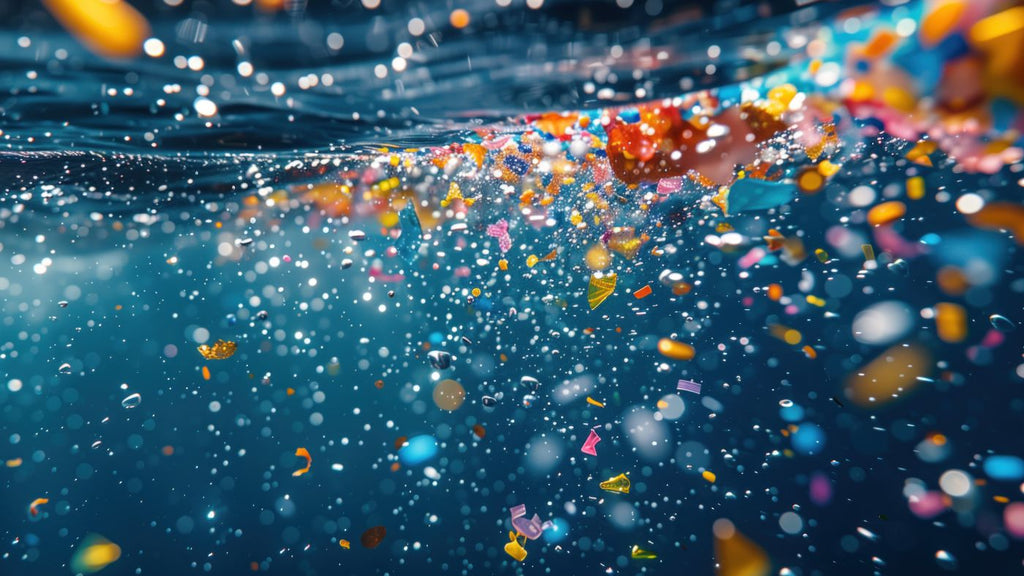And Yes, That Means There’s Plastic in Your Brain.
Let’s rewind. Picture a kitchen in the 1980s: glass milk bottles, metal lunchboxes, wooden utensils. Fast-forward to today, and we’re surrounded—suffocated—by plastic. From the moment we wake up on polyester sheets to the time we drink water from plastic bottles or microwave food in plastic containers, we’re unknowingly ingesting tiny shards of plastic with nearly every breath, bite, and sip.
And now? Scientists estimate the average human brain contains a full spoonful of microplastics. That’s up to 1% of our brain mass… made of plastic.
We’re not here to fearmonger—we’re here to wake people up. This is a call to action. Let’s break it down.
1. Throwback to the 1980s: What Happened?!

There was a time—within living memory—when we lived just fine without plastics touching every part of our food and life. Your grandparents drank from glass bottles, stored leftovers in ceramic or stainless steel, and wore clothes made from cotton and wool. Microplastics weren’t part of the menu.
The shift came fast. And it came with a cost.
2. We Now Consume 6x More Microplastics Than in 1980

Recent data shows that today’s average person consumes up to 5 grams of plastic per week—the equivalent of a credit card. That’s six times more than we were exposed to just a few decades ago.1
Plastics are now so omnipresent they’re found in:
-
Air and dust
-
Bottled water and tap water
-
Sea salt
-
Fruits and vegetables
-
Infant formula and breastmilk
Yes—even in our children.
3. Is This the Future You Want?

Take a look at the modern food pyramid meme we made: Microplastics. Seed oils. Bugs. Oat milk. Antidepressants.
We’re not saying the future is entirely bleak—but if we stay on this path, we’re feeding the next generation a diet that’s as fake and synthetic as the packaging it comes in.
4. Top Offender: Plastic Bottles

In one of the most comprehensive studies to date, researchers found that **plastic bottles are the leading source of microplastic ingestion.**2 Even BPA-free bottles still leach microparticles—especially when exposed to heat or reused.
Cold or warm, new or old—plastic bottles shed microscopic fibers into our water. They’re not filtered out. And they don’t just pass through us—they embed into our tissues, organs, and yes… the brain.
5. Grocery Shopping Today Feels Like Reading a Science Experiment

Ever feel like you need a chemistry degree to decode a food label?
You’re not alone. Most people can’t identify half the ingredients in ultra-processed foods—and buried within those mystery additives are plasticizers, emulsifiers, and petroleum-derived stabilizers.
The worst part? There’s no warning label for microplastics. They're in the packaging. They're in the product. They're in you.
6. Plastic in the Brain: Entire Spoonfuls Found

Multiple studies have now confirmed the unthinkable: Microplastics have been found in human brain tissue, where they can cause inflammation, oxidative stress, and even disrupt neural signaling.3
Let’s be clear: the brain is not supposed to contain plastic. But here we are.
Some researchers estimate the average person’s brain may now contain a full spoonful of microplastics—an unimaginable consequence of modern living.
7. Healthier Plastic Swaps That Actually Make a Difference

Don’t wait for regulation. You can reduce your exposure today with simple swaps:
-
✅ Drink from glass or stainless steel bottles
-
✅ Store leftovers in glass containers
-
✅ Use beeswax wrap instead of plastic wrap
-
✅ Ditch plastic cooking utensils for wood or stainless steel
-
✅ Sleep on natural fiber sheets like cotton or linen
-
✅ Wear natural fiber clothes (polyester is plastic!)
-
✅ Skip the dryer sheets—they’re plastic too
These steps may seem small, but they add up—especially when you're consistent.
8. What About Carnivore Bar Wrapping?

This one’s important.
Our goal has always been to make the most ancestral, shelf-stable bar possible—but modern food safety laws require certain concessions. That’s why Carnivore Bar is wrapped in a multilayer composite with a food-safe metalized film (similar to Mylar).
Why? Because it’s the only material that:
-
Blocks oxygen and moisture (essential for shelf stability)
-
Keeps your bar safe and sanitary without preservatives
-
Mimics the function of rawhide and tallow sealing used in traditional pemmican preparation
Ancestrally, pemmican was wrapped in dried animal hide and sealed with fat. When kept cool and dry, some batches have reportedly lasted over 50 years.
While we can’t legally use rawhide, our packaging offers the closest modern equivalent—keeping the bar fresh without toxic additives.
Final Thoughts
The plastic problem isn’t just environmental—it’s biological. It’s in our food, our bodies, our brains. But it’s not hopeless.
The Carnivore lifestyle—centered on nutrient-dense, animal-based foods—can help your body detox, rebuild, and defend itself. Zinc, selenium, B vitamins, and cholesterol found in red meat and organs are protective against endocrine disruptors and help neutralize oxidative stress caused by microplastics.
Recent Studies (MLA Style)
-
Senathirajah, Kavitha, et al. “Estimation of the Mass of Microplastics Ingested—A Pioneering Study.” Environmental Science & Technology, vol. 55, no. 12, 2021, pp. 8450–8463. https://doi.org/10.1021/acs.est.1c00138
-
Mason, Sherri A., et al. “Synthetic Polymer Contamination in Bottled Water.” Frontiers in Chemistry, vol. 6, 2018, Article 407. https://doi.org/10.3389/fchem.2018.00407
-
Horvatits, Thomas, et al. “Microplastics Detected in Human Brain Tissue.” Scientific Reports, vol. 13, no. 1, 2023, Article 9891. https://doi.org/10.1038/s41598-023-36920-0

